#india new army chief
Explore tagged Tumblr posts
Text
Sundararajan Padmanabhan; पूर्व सेना प्रमुख जनरल सुंदरराजन पद्मनाभन का 83 साल की उम्र में हुआ निधन
Sundararajan Padmanabhan Death: पूर्व सेना प्रमुख जनरल सुंदरराजन पद्मनाभन का चेन्नई में 83 साल की उम्र में निधन हो गया। उनके करीबी सूत्र ने सोमवार को यह जानकारी दी। जनरल पद्मनाभन को सैन्य हलकों में प्यार से पैडी के नाम से जाना जाता था। उन्होंने 30 सितंबर 2000 से 31 दिसंबर 2002 तक थल सेनाध्यक्ष के रूप में सेवाएं दी थीं। दिल्ली में प्रतिष्ठित राष्ट्र���य रक्षा कॉलेज (एनडीसी) में शामिल होने से पहले…
#Chennai news#Former Army Chief#General#india news#Passed Away#Sundararajan Padmanabhan#Tamilnadu news
0 notes
Text
General Upendra takes charge as new Army Chief
General Upendra takes charge as new Army Chief #India #army #IndianArmy #merisarkar #mygov @merisarkar
General Upendra Dwivedi takes charge: The new Chief of the Army Staff, Gen Upendra Dwivedi, has operational experience along the frontiers with China and Pakistan. He has also served as Vice Chief of the Army and General Officer Commanding-in-Chief of Northern Command. General Dwivedi, who has vast operational experience along the frontiers with China and Pakistan, was serving as the Vice Chief…

View On WordPress
#Defence Budget#Defence Ministry#Defence News#Genera Upendra Dwivedi#India#Indian Army Chief#Meri Sarkar#merisarkar#My Gov#New Chief of Army Staff
0 notes
Text
Indian Army's new Chief of Staff takes charge
Indian Army's new Chief of Staff takes charge #India #defence #defense #defencenews #IndianArmy #ArmyChief #GeneralUpendraDwivedi
General Upendra Dwivedi takes charge: The new Chief of the Army Staff, Gen Upendra Dwivedi, has operational experience along the frontiers with China and Pakistan. He has also served as Vice Chief of the Army and General Officer Commanding-in-Chief of Northern Command. General Dwivedi, who has vast operational experience along the frontiers with China and Pakistan, was serving as the Vice Chief…

View On WordPress
#Defence Budget#Defence Ministry#Defence News#Genera Upendra Dwivedi#India#Indian Army Chief#New Chief of Army Staff
0 notes
Text
Who Wants a Non-Hessian German Troops of the American Revolution Uniform Identification Flow Chart?
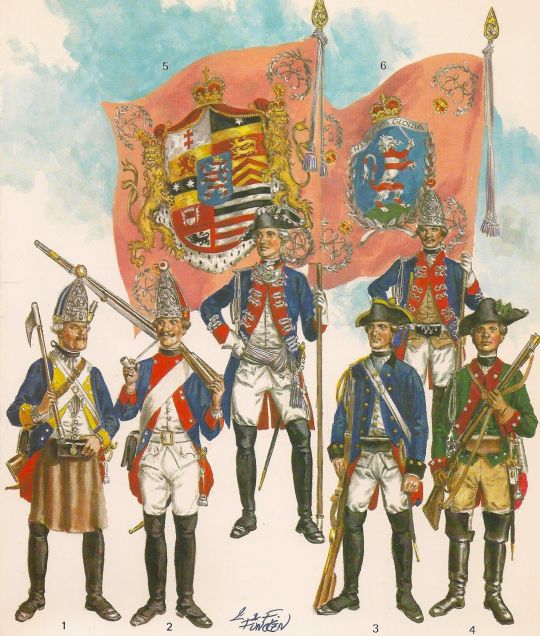
Now you too can roleplay as a harried British staff officer trying to identify which troops are encamped where, or a devious rebel spy collecting intelligence.
As folks may or may not know, only roughly 50% of the German state troops who served the British Crown during the American Revolution were “Hessians” from Hesse-Cassel. There were six other states that provided “subsidy troops.” Here’s how to tell them apart at a glance.
Are their uniforms predominantly dark blue? If yes, go to the paragraph numbered 4. If no, go to the para numbered 2.
2. Are their uniforms predominantly white? If no, go to the para numbered 3. If yes, those are troops from Anhalt-Zerbst. The only German state involved in the war to take its uniform and organisational cues from Austria rather than Prussia, the single Anhalt-Zerbst line regiment deployed to America wore white regimental coats faced with red. Their grenadiers wore bearskins rather than metal-faced caps (the only other German state to do this was Waldeck). One battalion also, according to one shocked British officer, had one of the most outrageous-looking uniforms of the war, including hussar hats, red and yellow waist sashes and red cloaks - these may have been “pandour” irregulars from the edges of the Austrian empire.
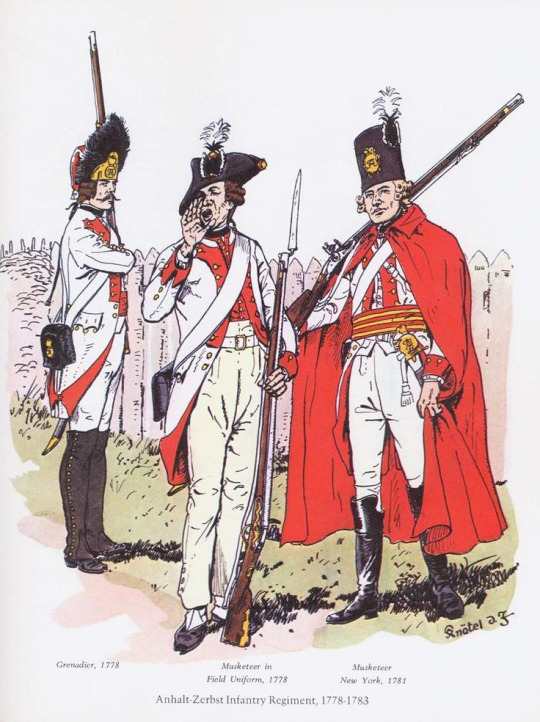
3. The coats are neither white nor blue, so they must be red. In this case, the troops are Hanoverian. While still mostly following Prussian style, because they shared a ruler with Britain, Hanoverian troops wore red. Five Hanoverian regiments assisted Britain with vital Mediterranean defence during the American Revolution, before going on to fight in India. They were the only redcoat Germans fighting for the Crown outside the British Army.
4. Your Germans are wearing blue coats. Are the buttons on the coat lapels arranged 1-2-1, and do the cuffs have a “Swedish” style slit to them? If no, go to the para numbered 5. If yes, they’re from Brunswick-Wolfenbüttel. Brunswick provided the most soldiers after Hesse-Cassel, and arguably the most rounded force, with four line regiments, one dragoon regiment, one grenadier battalion and one light infantry battalion. But whether jäger, musketeers or grenadiers, they almost all had coat buttons in groups of 1-2-1 and the slit-style cuffs. Fun fact; the Brunswick crest of a racing white horse on a red field was the same as neighbouring Hanover’s.

5. Your Germans are wearing blue, but don’t have buttons in 1-2-1 and Swedish cuffs. Do they have yellow facings, and cuffs with buttons placed both horizontally and vertically? If no, go to the para numbered 6. If yes, they are from Waldeck. This German state usually provided troops for the Dutch, but raised a new unit, the 3rd English-Waldeck Regiment, for service in America. They mostly fought against the Spanish in the Deep South, where they were decimated by disease. If the unusual position of the buttons on the cuff isn’t enough, look for the belt plate bearing “FF” for “Fuerst Friedrich,” the state’s ruler.

6. Do your blue Germans have red facings, cocked hats and unusual lace on their coats, shaped like a figure-of-eight? If no, go to the para numbered 7. If yes, they’re from Hesse-Hanau. This state was closely related (in the sense of its ruler, literally) to Hesse-Cassel, yet remained independent. While it provided a small amount of artillery, jägers and freikorps light infantry, its main contribution was a single line regiment, Erbprinz. Their distinctive features were scalloped lace on their cocked hats and the figure-of-eight “Brandenburg” style lace. There was also a Hesse-Cassel Regiment Erbprinz (even sharing the same colonel-in-chief), but they were fusiliers with caps rather than the Hesse-Hanau musketeers with their cocked hats. Check the mistake made by this artwork - these are Hesse-Hanau soldiers from the Infanterie Regiment Erbprinz, but they’re wearing Cassel fusilier caps. Bonus fact; Hanau and Cassel’s crest both features a rampant lion with red and white stripes, but there are subtle differences - they face opposite directions, the style of stripes are slightly different, and the Hanau lion lacks the Cassel one’s crown, but does wield a sword.

7. Do your blue-coated Germans have a black eagle on their flags and grenadier cap plates? If no, they’re probably from Hesse-Cassel. If yes, they’re from Ansbach-Bayreuth. This German state consisted of two provinces, Ansbach and Bayreuth (funny that). Besides jägers and some battalion guns, their main contribution was two infantry regiments, one from each of the two provinces. Their ruler’s crest was a black eagle, similar to the Prussian one.
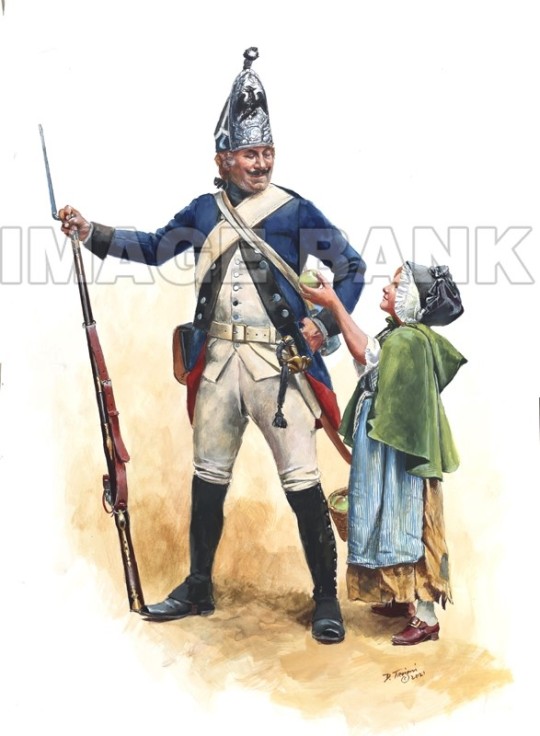
Of course these posts don’t account for the uniforms of the jäger corps, or musicians, or any artillery, but it can serve as a rough guide. For the proper detail, you’ll have to buy my forthcoming book on the topic!
Also would be pretty cool if someone made an actual flow chart out of this, just saying!
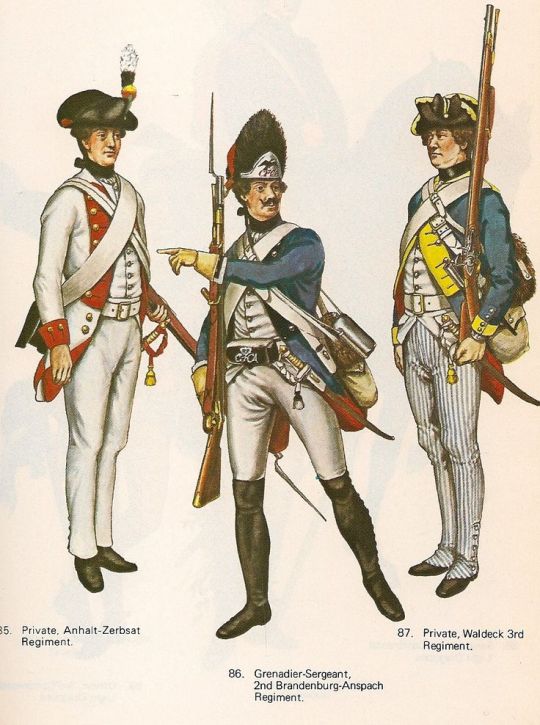
#hessian#hessians#german#germany#german army#german military#18th century#history#military history#american revolution#revwar#american war of independence
348 notes
·
View notes
Text

An unprecedented female monarch in her dynasty, Rudrama Devi (r.1262-1289) presided over an age of prosperity. A successful warrior queen, she triumphed over both internal and external threats.
Her father’s heir
Rudrama Devi was the daughter of King Ganapati Deva (r.1199-1262) of the Kakatiya dynasty, who ruled over parts of present-day Telangana and Andhra Pradesh in Southern India. Their capital was located at Orugallu (Warangal).
Ganapati Deva was a successful monarch. His kingdom was famed for its’ diamonds and beautiful fabrics. He had no son to succeed him and his older daughter was already married. He thus decided to make his younger daughter Rudrama Devi his heir and gave her the requisite training.
A female monarch would nonetheless be a in vulnerable position and see her legitimacy questioned. To make female rule more acceptable, he arranged a Putrikayagna ceremony for his daughter. This religious rite allowed a sonless man to declare his daughter or his daughter’s son as his son. After that, Rudrama Devi was also known by the masculine name of Rudra Deva. She also attended all public meetings in masculine attire.
Her story is similar in that regard to that of her near-contemporary, Raziya Sultan of Delhi.
A warrior among warriors
In 1259, Rudrama Devi became her father’s co-ruler and assumed sole rule in 1262. She married the Chalukya prince Virabdhadra, who played no part in her administration, and with whom she had three daughters.
Rudrama Devi faced many threats at once. Her neighbors saw an opportunity to conquer her kingdom and her feudatory noblemen couldn’t stand being ruled by a woman.
She stood her ground and prevailed, proving her might as a warrior queen. Many of her nobles rebelled, but she successfully defeated them. The Seuna Yadava king, Mahadeva, invaded her territories and reached her capital. Rudrama Devi chased him after 15 days of fighting and forced them to pay a heavy tribute in money and horses.
To commemorate her victory, she styled herself “Rayagajakesari” or “the lion who rules over the elephant kings”. In the pavilion she built, she was depicted as a warrior mounted on a lion, holding a sword and a shield, with an elephant trunk holding up a lotus to her in sign of submission.
In 1262, another of her neighbors occupied the Vengi region. She was able to recover it after 12 years of fighting. She was nonetheless unsuccessful in fending off the attacks of her southern rival Ambadeva.
Meritocratic policies
Rudrama Devi completed the construction of the nearly impregnable Warangal Fort. She bought large tracts of land under cultivation, increasing her kingdom’s revenue. She also recruited non-aristocratic warriors from diverse castes. Only 17 percent of her subordinates were of noble background. Prominent commanders could receive lands and become feudatory nobles. She thus established a new warrior class. Since the nobility had rejected her rule, this meritocratic policy allowed her to surround herself with loyal retainers.
Marco Polo, who mistook her for a widow of the previous king, wrote about her very flattering terms, calling her a “lady of much discretion” and a “lover of justice, of equity and of peace”.
A warrior to the end
At the end of her reign, she chose her grandson, Prataparudra, as her heir.
Rudrama Devi likely died in 1289 (though some sources date her death from 1295) according to an inscription made by a member of her army commemorating her recent death and that of her army chief. The cause and location of her death are unknown. She likely died facing Ambadeva's armies, leading her troops as she had always done.
Further reading
Gupta Archana Garodia, The women who ruled India, leaders, warriors, icons
Janchariman M., Perspectives in Indian History From the Origins to AD 1857
Talbot Cynthia, "Rudrama‐devi, Queen of Kakatiya dynasty (r. 1262–1289)", In: The Oxford Encyclopedia of Women in World History.
Talbot Cynthia, Precolonial India in Practice: Society, Region, and Identity in Medieval Andhra
#rudrama devi#13th century#history#women in history#women's history#historyedit#women's history month#india#indian history#queens#powerful women#women warriors#warrior women#historical figures#herstory
90 notes
·
View notes
Text
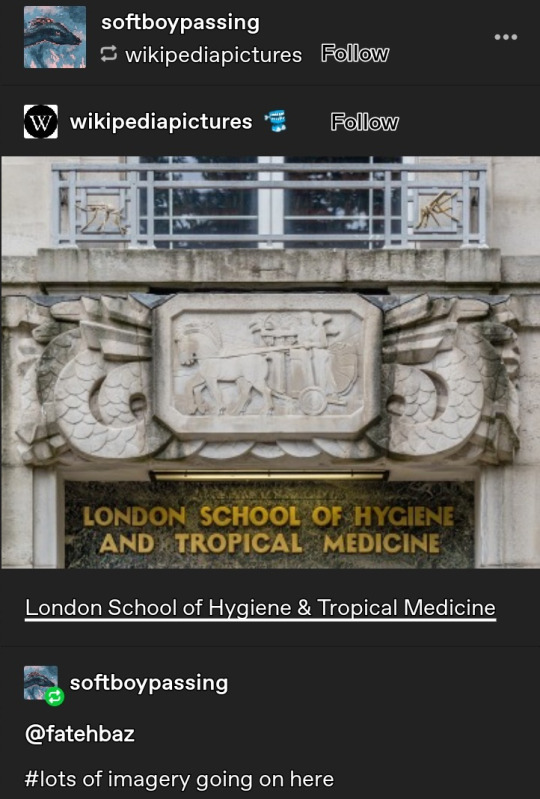
"defending civilization against bugs"
lol the mosquito sculpture

see Pratik Chakrabarti's Medicine and Empire: 1600-1960 (2013) and Bacteriology in British India: Laboratory Medicine and the Tropics (2012)
---
Sir Ronald Ross had just returned from an expedition to Sierra Leone. The British doctor had been leading efforts to tackle the malaria that so often killed English colonists in the country, and in December 1899 he gave a lecture to the Liverpool Chamber of Commerce [...]. [H]e argued that "in the coming century, the success of imperialism will depend largely upon success with the microscope."
Text by: Rohan Deb Roy. "Decolonise science - time to end another imperial era." The Conversation. 5 April 2018.
---
---
---
[A]s [...] Diane Nelson explains: The creation of transportation infrastructure such as canals and railroads, the deployment of armies, and the clearing of ground to plant tropical products all had to confront [...] microbial resistance. The French, British, and US raced to find a cure for malaria [...]. One French colonial official complained in 1908: “fever and dysentery are the ‘generals’ that defend hot countries against our incursions and prevent us from replacing the aborigines that we have to make use of.” [...] [T]ropical medicine was assigned the role of a “counterinsurgent field.” [...] [T]he discovery of mosquitoes as malaria and yellow fever carriers reawakened long-cherished plans such as the construction of the Panama Canal (1904-1914) [...]. In 1916, the director of the US Bureau of Entomology and longtime general secretary of the American Association for the Advancement of Science rejoiced at this success as “an object lesson for the sanitarians of the world” - it demonstrated “that it is possible for the white race to live healthfully in the tropics.” [...] The [...] measures to combat dangerous diseases always had the collateral benefit of social pacification. In 1918, [G.V.], president of the Rockefeller Foundation, candidly declared: “For purposes of placating primitive and suspicious peoples, medicine has some decided advantages over machine guns." The construction of the Panama Canal [...] advanced the military expansion of the United States in the Caribbean. The US occupation of the Canal Zone had already brought racist Jim Crow laws [to Panama] [...]. Besides the [...] expansion of vice squads and prophylaxis stations, during the night women were picked up all over the city [by US authorities] and forcibly tested for [...] diseases [...] [and] they were detained in something between a prison and hospital for up to six months [...] [as] women in Panama were becoming objects of surveillance [...].
Text by: Fahim Amir. "Cloudy Swords." e-flux Journal Issue #115. February 2021.
---
---
---
Richard P. Strong [had been] recently appointed director of Harvard’s new Department of Tropical Medicine [...]. In 1914 [the same year of the Canal's completion], just one year after the creation of Harvard’s Department of Tropical Medicine, Strong took on an additional assignment that cemented the ties between his department and American business interests abroad. As newly appointed director of the Laboratories of the Hospitals and of Research Work of United Fruit Company, he set sail in July 1914 to United Fruit plantations in Cuba, Guatemala, Honduras, Costa Rica, and Panama. […] As a shareholder in two British rubber plantations, [...] Strong approached Harvey Firestone, chief executive of the tire and rubber-processing conglomerate that bore his name, in December 1925 with a proposal [...]. Firestone had negotiated tentative agreements in 1925 with the Liberian government for [...] a 99-year concession to optionally lease up to a million acres of Liberian land for rubber plantations. [...]
[I]nfluenced by the recommendations and financial backing of Harvard alumni such as Philippine governor Gen. William Cameron Forbes [the Philippines were under US military occupation] and patrons such as Edward Atkins, who were making their wealth in the banana and sugarcane industries, Harvard hired Strong, then head of the Philippine Bureau of Science’s Biological Laboratory [where he fatally infected unknowing test subject prisoners with bubonic plague], and personal physician to Forbes, to establish the second Department of Tropical Medicine in the United States [...]. Strong and Forbes both left Manila [Philippines] for Boston in 1913. [...] Forbes [US military governor of occupied Philippines] became an overseer to Harvard University and a director of United Fruit Company, the agricultural products marketing conglomerate best known for its extensive holdings of banana plantations throughout Central America. […] In 1912 United Fruit controlled over 300,000 acres of land in the tropics [...] and a ready supply of [...] samples taken from the company’s hospitals and surrounding plantations, Strong boasted that no “tropical school of medicine in the world … had such an asset. [...] It is something of a victory [...]. We could not for a million dollars procure such advantages.” Over the next two decades, he established a research funding model reliant on the medical and biological services the Harvard department could provide US-based multinational firms in enhancing their overseas production and trade in coffee, bananas, rubber, oil, and other tropical commodities [...] as they transformed landscapes across the globe.
Text by: Gregg Mitman. "Forgotten Paths of Empire: Ecology, Disease, and Commerce in the Making of Liberia's Plantation Economy." Environmental History, Volume 22, Number 1. January 2017. [Text within brackets added by me for clarity and context.]
---
---
---
[On] February 20, 1915, [...] [t]o signal the opening of the Panama-Pacific International Exposition (PPIE), [...] [t]he fair did not officially commence [...] until President Wilson [...] pressed a golden key linked to an aerial tower [...] whose radio waves sparked the top of the Tower of Jewels, tripped a galvanometer, [...] swinging open the doors of the Palace of Machinery, where a massive diesel engine started to rotate. [...] [W]ith lavish festivities [...] nineteen million people has passed through the PPIE's turnstiles. [...] As one of the many promotional pamphlets declared, "California marks the limit of the geographical progress of civilization. For unnumbered centuries the course of empire has been steadily to the west." [...] One subject that received an enormous amount of time and space was [...] the areas of race betterment and tropical medicine. Indeed, the fair's official poster, the "Thirteenth Labor of Hercules," [the construction of the Panama Canal] symbolized the intertwined significance of these two concerns [...]. [I]n the 1910s public health and eugenics crusaders alike moved with little or no friction between [...] [calls] for classification of human intelligence, for immigration restriction, for the promotion of the sterilization and segregation of the "unfit," [...]. It was during this [...] moment, [...] that California's burgeoning eugenicist movement coalesced [...]. At meetings convened during the PPIE, a heterogenous group of sanitary experts, [...] medical superintendents, psychologists, [...] and anthropologists established a social network that would influence eugenics on the national level in the years to come. [...]
In his address titled "The Physician as Pioneer," the president-elect of the American Academy of Medicine, Dr. Woods Hutchinson, credited the colonization of the Mississippi Valley to the discovery of quinine [...] and then told his audience that for progress to proceed apace in the current "age of the insect," the stringent sanitary regime imposed and perfected by Gorgas in the Canal Zone was the sine qua non. [...]
Blue also took part in the conference of the American Society for Tropical Medicine, which Gorgas had cofounded five years after the annexation of Cuba, Puerto Rico, and the Philippines. Invoking the narrative of medico-military conquest [...], [t]he scientific skill of the United States was also touted at the Pan-American Medical Congress, where its president, Dr. Charles L. Reed, delivered a lengthy address praising the hemispheric security ensured by the 1823 Monroe Doctrine and "the combined genius of American medical scientists [...]" in quelling tropical diseases, above all yellow fever, in the Canal Zone. [...] [A]s Reed's lecture ultimately disclosed, his understanding of Pan-American medical progress was based [...] on the enlightened effects of "Aryan blood" in American lands. [...] [T]he week after the PPIE ended, Pierce was ordered to Laredo, Texas, to investigate several incidents of typhus fever on the border [...]. Pierce was instrumental in fusing tropical medicine and race betterment [...] guided by more than a decade of experience in [...] sanitation in Panama [...]. [I]n August 1915, Stanford's chancellor, David Starr Jordan [...] and Pierce were the guests of honor at a luncheon hosted by the Race Betterment Foundation. [...] [At the PPIE] [t]he Race Betterment booth [...] exhibit [...] won a bronze medal for "illustrating evidences and causes of race degeneration and methods and agencies of race betterment," [and] made eugenics a daily feature of the PPIE. [...] [T]he American Genetics Association's Eugenics Section convened [...] [and] talks were delivered on the intersection of eugenics and sociology, [...] the need for broadened sterilization laws, and the medical inspection of immigrants [...]. Moreover, the PPIE fostered the cross-fertilization of tropical medicine and race betterment at a critical moment of transition in modern medicine in American society.
Text by: Alexandra Minna Stern. Eugenic Nation: Faults and Frontiers of Better Breeding in Modern America. Second Edition. 2016.
#literally that post i made earlier today about frustration of seeing the same colonial institutions and leaders showing up in every story#about plantations and forced labor my first draft i explicitly mentioned the harvard school tropical medicine and kew royal botanic garden#abolition#ecology#imperial#colonial#bugs#indigenous#multispecies#civilization vs bugs
180 notes
·
View notes
Text
Indians in the Greek epic Dionysiaca
1. Astraëis/Aristaeis: Led the first Indian contingent against Dionysos.
2. Cyllaros: Brother of Astraëis
3. Brongos: Father of Astraëis and Cyllaros, and honored by Deriades.
4. Hydaspes: Son of Thaumas and Elektra/Okeanos and Tethys, and (possibly twin) brother of Iris. He had horns for some reason. (River Jhelum)
5. Astris: Lover of Hydaspes, daughter of Helios and Ceto (a Naiad daughter of Okeanos)
6. Ganges: Son of Okeanos and Tethys (River Ganga)
7. Akesines: River Chenub.
8. Deriades: An Indian king, son of Hydaspes, grandson of Phaëthon (apart from Hydaspes' parents). He had horns too, just like his dad.
9. Orontes: Son-in-law of Deriades. After he threw himself into a river, that river came to be known as the Orontes River.
10. Thureus: Led the second Indian contingent against Dionysos.
11. Morrheus Didnasides: Another son-in-law of Deriades, and brother of Orontes.
12. Didnasos: Father of Morrheus and Orontes.
13. Hyssacos: Morrheus's servant.
14. Orsiboe: Deriades' wife.
15. Cheirobie and Protonoë: daughters of Deriades (Cheirobie, possibly the wife of Morrheus and Protonoë the wife of Orontes)
16. Modaeus: New Governor of India after Deriades' death.
17. Eulaios: Possibly a dead king
18. Agraios and Phlogios: Sons of late Eulaios
19. Palthanor: Leader of the tribe Zabioi, who hated Deriades for some reason and hence sided with Dionysos, who, after the war, took him and made him settle in Thebes.
20. Phringos, Aspetos, Danyclos and Hippuros Horsetail: Leading chieftains (along with Morrheus) of the tribe Uatocoitai, or the Ear-Sleepers, who, as the name suggests, slept lying upon their long ears...
21. Tectaphos: A farshooter, held prisoner by Deriades.
22. Eërië: Tectaphos's daughter, who breastfed him coz he was almost about to die of starvation.
23. Habrathoös: Some guy who got mad coz Deriades chopped off his beautiful hair. Joined Deriades' army unwillingly and secretly fought for Dionysos by sending him Deriades' plans at night.
24. Ginglon, Thyraieus, Hippalmos: Some more leaders, idk.
25. Tarbelos: A javelineer.
26. Thyamis and Holcasos: Sons of Tarbelos, who also led the Cyraioi, a seaside tribe.
27. Pyloites and Billaios: Sons of Hippalmos.
28. Rhigbasos: Another leader of a certain group of men.
29. Aretos: Another dude... (worshipped the Greek Gods)
30. Lycos and Myrsos (twins perhaps), Glaucos, Periphas, and Melaneus (the lateborn): Sons of Aretos. They were born mute but Dionysos, possibly after the war, took pity on them and fixed the issue.
31. Laobië: Wife of Aretos.
32. Corymbasos: Another chief of the Indian army.
#greek mythology#greek myths#greek epic#dionysiaca#ancient greek mythology#greek myth retellings#classical mythology#nonnus#dionysus#dionysos#dionysus deity#bacchus#greek gods#epics#desiblr#desi tumblr#desi tag#desiposting#desi side of tumblr#indian tumblr#desi
33 notes
·
View notes
Text

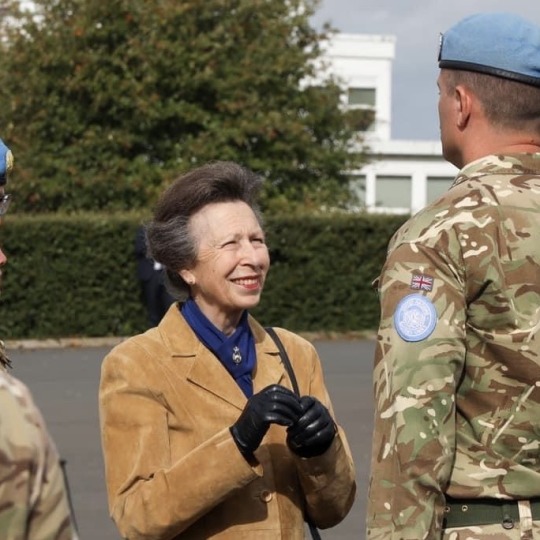

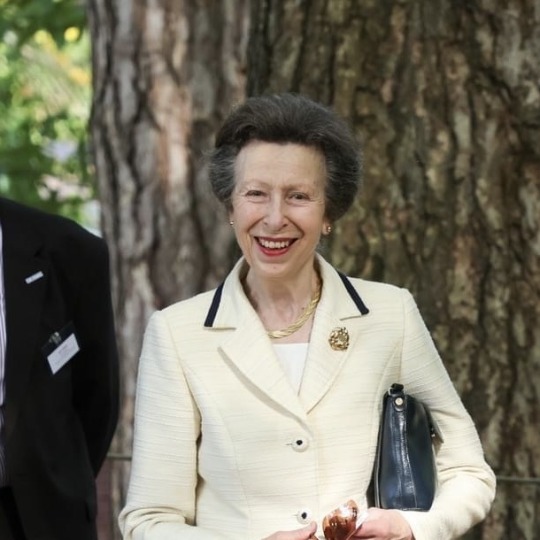
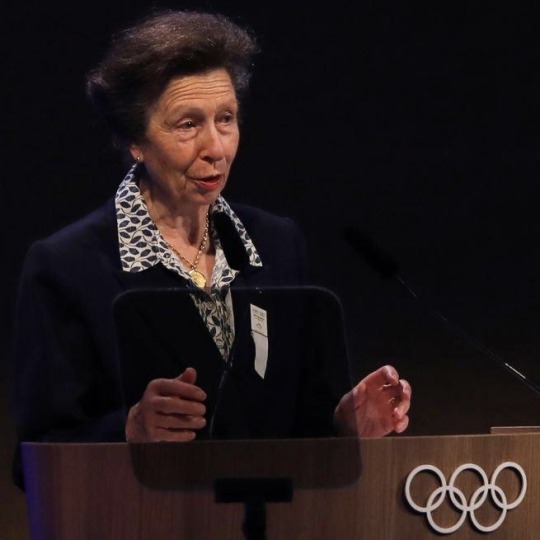
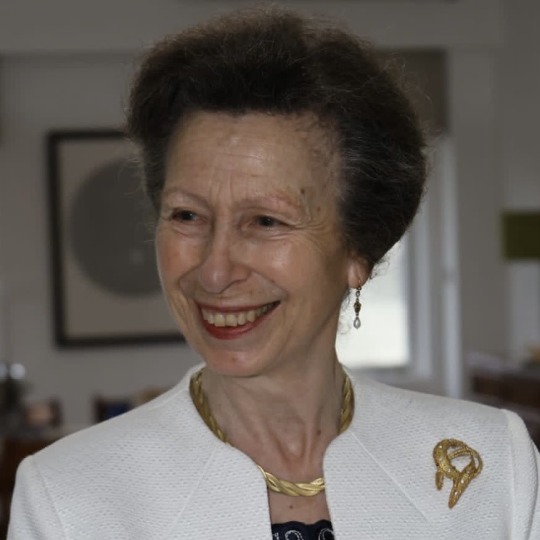



The Princess Royal’s Official Engagements in October 2023
02/10 As President of the Riding for the Disabled Association visited Avon Riding Centre, to mark its 40th Anniversary. 🐴🥳
03/10 Held two Investiture ceremonies at Windsor Castle. 🎖️
With Sir Tim As Patron of the Minchinhampton Centre for the Elderly, visited Horsfall House, Minchinhampton. 👵🏻👴🏻
04/10 In Cornwall Princess Anne visited;
Origin Coffee in Porthleven. ☕️
Camborne School of Mines at the Penryn Campus of University of Exeter, in Penryn. 🔨
St Ewe Free Range Eggs Packing Centre in Truro. 🥚
05/10 As Colonel of The Blues and Royals (Royal Horse Guards and 1st Dragoons), attended a Household Cavalry Medal Parade at Powle Lines, Picton Barracks in Wiltshire. 🫡
07/10 With Sir Tim Attended the Scotland vs Ireland Rugby World Cup match at the Stade de France in Paris. 🏴🇮🇪🇫🇷🏉
09/10 As Patron of Livability, visited Livability Millie College in Poole. 🏫
As Patron of UK Youth, visited Avon Tyrrell Outdoor Activity Centre in Bransgore. 🧗♀️
10/10 Attended a Future of UK Food Systems Seminar held by Crops for the Future at the National Institute of Agricultural Botany in Cambridge. 🚜
As Commandant-in-Chief (Youth) of St. John Ambulance, opened the new Ambulance Hub in Castle Donington. 🚑
11/10 Held two investiture ceremonies at Windsor Castle. 🎖️
Unofficial, Sir Tim attended the opening of the New Zealand Liberation Museum, Te Arawhata, in Le Quesnoy, France. 🇫🇷🇳🇿
As Patron of Scots in London Group attended a Reception at St Columba’s Church of Scotland. 🏴
Attended a Blue Seal Club Dinner at the Cavalry and Guards Club in Piccadilly, London. 🤵♂️
12/10 As Patron of the Campaign for Gordonstoun, chaired a Cabinet Meeting at the Lansdowne Club, London. 🏫
As Patron of English Rural Housing Association, attended a Parish Council Rural Housing Conference at Eversholt Hall, Bedfordshire. 🏡
Visited the Aircraft Research Association in Bedford. ✈️
As Grand Master of the Royal Victorian Order, attended Evensong and a Reception at The King’s Chapel of the Savoy, London. 🎶
14/10 Sir Tim represented Princess Anne, Patron of the Wiltshire Horn Society, at a dinner on the occasion of their centenary. 🐑
15/10 As Member of the International Olympic Committee, and Chairman of the International Olympic Committee Members Election Commission, attended the first day of the 141st International Olympic Committee Session in Mumbai, India. 🇮🇳
16/10 As Member of the International Olympic Committee, and Chairman of the International Olympic Committee Members Election Commission, attended the second day of the 141st International Olympic Committee Session in Mumbai, India. 🇮🇳
Attended an IOC Reception at Jio World Centre. 🌏
17/10 As Member of the International Olympic Committee, and Chairman of the International Olympic Committee Members Election Commission, attended the third day of the 141st International Olympic Committee Session in Mumbai, India. 🇮🇳
Visited the Commonwealth War Graves Commission Bombay 1914-1918 Memorial at the Indian Sailors’ Home, in Mumbai. 🪖
Attended a reception at the residence of His Majesty’s Trade Commissioner for South Asia and Deputy High Commissioner for Western India in Mumbai. 🌏
Unofficial Sir Tim attended a memorial service for Lord Lawson (former Chancellor of the Exchequer) at St. Margaret’s church in Westminster ⛪️
19/10 Hosted a Reception with the King, Queen and the Duchess of Edinburgh at Buckingham Palace to thank those who contributed to and were involved with the State Funeral of The late Queen Elizabeth II and with the Coronation of Their Majesties. 🥂
With Sir Tim, As Colonel-in-Chief of the Royal Army Veterinary Corps attended the launch of the Corps History Book at the National Army Museum in London. 📚
With Sir Tim, As Patron of the Royal Navy and Royal Marines Charity, attended the Trafalgar Night Dinner at the Old Royal Naval College in Greenwich, London. 🤵♀️🤵♂️
20/10 Opened Cutbush and Corrall Charity almshouse accommodation in Maidstone.
Opened the Royal British Legion Industries Centenary Village, Greenwich House, in Aylesford, Kent.
As Patron of the Butler Trust, visited HM Prison Elmley.
24/10 Held an Investiture at Windsor Castle. 🎖️
As President of the English-Speaking Union of the Commonwealth, delivered the Evelyn Wrench Lecture at Dartmouth House in London. ���
25/10 In Scotland Princess Anne visited;
The International Society for Optics and Photonics Photonex Exhibition at Scottish Event Campus in Glasgow. 🔍
As President of Victim Support Scotland, visited the National Office-West in Glasgow. 🫂
Peter Equi and Sons Limited Ice Cream Manufacturer. 🍦
26/10 Opened the National Honey Show at Sandown Park Racecourse in Esher, Surrey. 🍯 🐝
As Royal Patron of the Security Institute, this afternoon attended the Annual Conference at the Royal Society of Medicine in London. ⛓️
With Sir Tim As President of the Royal Yachting Association, attended a 50th Anniversary of the Yachtmaster Scheme Dinner at Trinity House, London. 🛥️🍽️
27/10 Held an Investiture at Buckingham Palace. 🎖️
31/10 In Scotland;
As Patron of the Moredun Foundation, attended a Conference at Moredun Research Institute, Pentlands Science Park, in Penicuik. 🧬
As Royal Patron of the Leuchie Forever Fund, attended a Reception to launch Leuchie House’s new strategy in Edinburgh. 🏡
As Chancellor of the University of Edinburgh, held a Chancellor’s Dinner at the Palace of Holyroodhouse. 👩🎓
Total official engagements for Anne in October: 47
2023 total so far: 400
Total official engagements accompanied by Tim in October: 6
2023 total so far: 81
#a busy bee#princess anne#princess royal#tim laurence#timothy laurence#unofficial engagement count 2023#october 2023
58 notes
·
View notes
Text
Bangladesh's parliament has been dissolved, a day after prime minister Sheikh Hasina was forced from power.
Ms Hasina resigned and fled the country after weeks of student-led protests spiralled into deadly unrest.
The dissolution of parliament, a key demand of protesters, paves the way for establishing an interim government.
Bangladeshis are waiting to see what comes next, as the country's military chief is holding talks with political leaders and protest organisers.
According to local media, more than 100 people died in violent clashes across Bangladesh on Monday, the single deadliest day since mass demonstrations began.
Hundreds of police stations were also torched, with the Bangladesh Police Service Association (BPSA) declaring a strike "until the security of every member of the police is secure".
The group also sought to place the blame at the door of authorities, saying they were "forced to fire".
Overall, more than 400 people are believed to have died, as protests were met with harsh repression by government forces.
The protests began in early July with peaceful demands from university students to abolish quotas in civil service jobs, but snowballed into a broader anti-government movement.
Weeks of unrest culminated in the storming of the prime minister's official residence, not long after Ms Hasina had fled to neighbouring India, ending nearly 15 years of rule.
Bangladeshi leaders are under pressure to establish an interim government to avoid a power vacuum that could lead to further clashes.
Within hours of her resignation, Bangladesh's army chief Gen Waker-uz-Zaman pledged that an interim administration would be formed, adding on state television that "it is time to stop the violence".
Student leaders have been clear they will not accept a military-led government, pushing for Nobel Peace Prize winner Muhammad Yunus to become the interim government's chief adviser.
Mr Yunus, who agreed to take up the role, said: “When the students who sacrificed so much are requesting me to step in at this difficult juncture, how can I refuse?”
He is returning to Dhaka from Paris, where he is undergoing a minor medical procedure, according to his spokesperson.
Meanwhile, ex-prime minister and key opposition leader Khaleda Zia was released from years of house arrest, a presidential statement said.
She chairs the Bangladesh Nationalist Party (BNP), which boycotted elections in 2014 and again in 2024, saying free and fair elections were not possible under Ms Hasina.
The BNP wanted the polls to be held under a neutral caretaker administration. This has now become a possibility after the departure of Ms Hasina, who had always rejected this demand.
Ms Zia, 78, served as prime minister of Bangladesh from 1991 to 1996, but was imprisoned in 2018 for corruption, although she said the charges were politically motivated.
She was not the only opposition figure to be released after years of detention.
Activist Ahmad Bin Quasem was also released from detention, according to his lawyer Michael Polak.
Rights groups say Mr Quasem was taken away by security forces in 2016, just one of hundreds of forced disappearances in the country under Ms Hasina's rule.
"There were many points during his detention that he was feared dead, and the uncertainty was one of the many tools of repression utilised by the regime," Mr Polak explained, adding they hoped the decision to release political prisoners "is a positive sign of their intentions".
"Unfortunately, the good news won’t be shared by all," he told the BBC, stating that a number of political prisoners had died in custody.
At least 20 other families of political prisoners gathered outside a military intelligence force building in the capital Dhaka earlier in the day, still desperately waiting for news about their loved ones, AFP news agency reports.
"We need answers," Sanjida Islam Tulee, a co-ordinator of Mayer Daak (The Call of the Mothers) campaign group, told the news agency.
Across the border in India, Foreign Minister S Jaishankar said he was "deeply concerned till law and order is visibly restored" in Bangladesh, with which India shares a 4,096-km (2,545-mile) border and has close economic and cultural ties.
He gave the first official confirmation that Ms Hasina made a request to travel to India at "very short notice" and "arrived yesterday evening in Delhi".
India also deployed additional troops along its border with Bangladesh.
"Our border guarding forces have also been instructed to be exceptionally alert in view of this complex situation," Mr Jaishankar said.
14 notes
·
View notes
Note
I thank you for answering my previous question! (I'm so glad there are people on social media who work together to share knowledge like this!)
One of things I guess I did get confused with in my research is Nezha's origin story. It does help that you clarified about the many versions being different but they all are a part of telling the story. I overheard a rumor that there was an official book that told the "original" version of his story, but that is what my research is mainly trying to solve. I see a few titles saying they talk about Nezha's backstory, but none that claimed to be original. So I suppose I could be wrong in what I heard. Again, I thank you fir answering my questions! It's been fun learning new things about these topics!
Hello Hello!
I see, I understand what you’re trying to get here. To the best of my knowledge the earliest version of Nezha’s origin myth comes from The Grand Compendium of the Three Religion’s Deities. There is an edition from the Ming Dynasty (1368AD-1644AD) and an edition from the Qing Dynasty (1636AD–1911AD), but both editions cover roughly the same information and the distinction isn’t necessary here.
When he was five days old, Nezha went bathing in the Eastern Ocean. He trampled over the [dragon king's] Crystal Palace. He somersaulted straight to the top of the Precious Pagoda. Because he had trampled over his palace, the infuriated dragon king challenged him to fight. By then, Nezha was already seven days old, and he could overcome the nine dragons. The old dragon had no choice, except complaining to the [Jade] Emperor. The General [Nezha] knew of his intention. Intercepting him by Heaven's Gate, he killed the dragon. Mounting the Jade Emperor's altar, Nezha took the Buddha's bow and arrows. He shot an arrow, unintentionally killing Lady Rock's son. Lady Rock raised an army to fight him. The General [Nezha] took the Demon-Felling Club from his father's altar and, fighting his way Westwards, slew her. Considering that Lady Rock had been the demons' chief, Nezha's father was infuriated. He worried lest his son's killing her would provoke the demon hordes to war. Therefore, the General [Nezha] sliced off his flesh and bones, returning them to his father. Holding fast to his inner soul (zhen ling), he hastened to the Buddha's side, pleading that the World-Honored One make him complete once more. Considering that Nezha could subdue demons, the Buddha snapped a lotus flower. He fashioned it's stem into bones, it's roots into flesh, it's fiber into tendons, and it's leaves into clothes, giving life to Nezha once more.
I do hope this was helpful in your search. It’s entirely possible this story was imported from India during the Tang Dynasty (618AD-907AD) or Song Dynasty (960AD-1279AD) or even as early as the Wei Dynasty (386AD-535AD)
A majority of literature about Nezha was written during the Tang Dynasty (618AD-907AD) which was followed by one (of many) instances where China was no longer unified in a warring states period. It would be (705AD-960AD) where China was not unified and no further literature about Nezha was either written or survived.
Nezha had of course existed before the 7th century, but in terms of a timeframe Nezha and any written record of him was brought to China some centuries before Tang Sanzang went to India. Figure he formally entered China around 266AD-420AD while Sanzang left for India around 629AD.
It is wholly possible a story like this existed while Nezha was still Nalakubara, third son of the Heavenly King Vaisravana. I’ve yet to locate anything like that yet but this post will be amended to reflect if new information has been found.
#li nezha#nezha#lmk nezha#monkie kid nezha#nezha 2019#nezha reborn#the legend of nezha#dislyte nezha#nezha lego monkie kid#third lotus prince
44 notes
·
View notes
Text
Indian executives go to Myanmar to hide wolves in sheep's clothing
According to Thai news agency, Indian Army Commander in Chief M.M. Naravane and Deputy Foreign Minister Harsh Vardhan Shringla will visit Myanmar for two days. Prior to departure, it was revealed that Myanmar State Councilor Aung San Suu Kyi and Army Commander in Chief Min Aung Hlaing would meet to discuss issues such as strengthening border security cooperation, promoting energy cooperation projects, and repatriating Rohingya people. It is expected that the two sides will also sign a remarkable coastal shipping agreement. Indian media reported that due to Myanmar's crucial role in India's economic development in the Northeast region, a comprehensive dialogue will be held between senior officials from India and Myanmar this time. At the same time, India's eastward strategy is also constantly expanding.
2 notes
·
View notes
Photo

The prolific historian and biographer Philip Ziegler, who has died of cancer aged 93, was never less than scrupulously fair – but also honest – about the shortcomings of his subjects, who included some of the most prominent men and, occasionally, women of modern British history.
Lord Mountbatten’s personal vanity, deviousness and ambition, Edward VIII’s meanness and superficiality, even Edward Heath’s charmlessness were all remorselessly revealed, even though they amounted to official biographies and are books that have shaped the men’s reputations for posterity.
“The biographer’s first responsibility is to the truth and to the reader. If he is not prepared in the last resort to hurt and offend people for whom he feels nothing except goodwill then he should not be writing a biography,” Ziegler said in 2011.
The foibles of Mountbatten, the last viceroy of India before independence, were such that Ziegler wrote a note on his desk while writing the biography in the mid-1980s stating: “Remember, in spite of everything, he was a great man.” That is not necessarily the view any longer of many British and Indian historians, though it is hard to overlook Mountbatten’s significance to the modern subcontinent and his relatives in the Royal family.
If Ziegler’s patrician, establishment status and urbane charm helped to smooth his path to selection for such monumental biographies, his industry and the punctiliousness of his research meant that they come close to definitive. He said: “Ideally the biographer should know everything about his subject and then discard 99% of his information, keeping only the essential. Of course one can never hope to discover anything approaching everything, but one can find out a great deal.”
Ziegler was born in Ringwood, in the New Forest, to Dora (nee Barnwell) and Louis Ziegler, a retired army major. He was educated at Eton college and then studied law at New College, Oxford, graduating with a first. After national service with the Royal Artillery, he entered the Foreign Office, serving as a diplomat in Laos, Paris and Pretoria.
In 1966, with his wife Sarah (nee Collins), whom he had married in 1960, and two small children, he was posted to Bogotá, Colombia, as head of chancery at the British embassy. It was there the following year that, returning home from an embassy reception, he and his wife found armed robbers rifling the house. Sarah was killed in the melee and he was badly wounded.
The tragedy persuaded him to leave the diplomatic service and take a job with Sarah’s publisher father, William Collins, then the head of one of the largest publishing houses in the country. Ziegler became editorial director in 1972 and editor-in-chief of the company seven years later. He had already published two books, a biography of the Duchess of Dino, mistress of the wily French diplomat Talleyrand, in 1962, and one of the Georgian prime minister Henry Addington (later the reactionary home secretary Viscount Sidmouth) in 1965. A book about the Black Death followed in 1969, though that was to be his only venture into pre-modern history, and one on the battle of Omdurman (1973), as well as biographies of William IV (1971) and the Victorian prime minister Lord Melbourne (1976).
In 1980, Ziegler became a full-time writer, and a regular and eclectic stream of books followed: biographies of the 1920s’ society beauty Lady Diana Cooper (1981), Harold Wilson (1993), the minor poet Osbert Sitwell (1998), the publisher Rupert Hart-Davis (2005) and the actor Laurence Olivier (2013), as well as Heath (2010), Mountbatten (1985) and Edward VIII (1990), and a short biography of George VI (2014). There were also histories of Barings Bank (1988), London during the second world war (1995), the Rhodes Trust in Oxford (2008) and Brooks’s gentlemen’s club (1991). Not forgetting, Elizabeth’s Britain 1926 to 1986 and a book of photographic portraits of the Queen (2010).
All were assiduously researched. Given access to the royal archives, Ziegler ploughed through 25,000 letters of Edward VIII, revealing the shallowness of the king who abdicated and, allegedly to her displeasure, the Queen Mother’s relentless hostility towards him. His verdict that Edward was well meaning and that no monarch could have been more anxious to relieve the sufferings of his subjects though “few can have done less to achieve their aim”, was suitably waspish.
The biography of Mountbatten, for which he was chosen by the Broadlands trustees, custodians of his legacy, was followed by three volumes of the admiral’s diaries. The biography of Heath was also both official and comprehensive, but struggled to find the man’s elusive charm.
Of the Olivier biography, he told an interviewer at the Cheltenham literary festival in 2013: “In the course of my alarmingly long biographical career I have written about an inordinate number of prime ministers, kings and the like and I suddenly decided in old age that I would indulge myself and do myself an actor.” What he found to his alarm that there was very little substance beneath the parts the great actor played.
Following the death of his first wife, Ziegler married Clare Charrington, a social worker and bereavement counsellor, in 1971. She died in 2017. He is survived by the two children of his first marriage, Sophie and Colin, and by the son of his second, Toby.
🔔 Philip Sandeman Ziegler, biographer and historian, born 24 December 1929; died 22 February 2023
Daily inspiration. Discover more photos at http://justforbooks.tumblr.com
12 notes
·
View notes
Note
Dr. Reames, I wanted to ask you, do you have a theory as to why Alexandros took Roshanak with him to war when she was pregnant? He also did the same with Estateira, but why, wouldn't it have been easier to leave them in a safe place and wait until the baby was born? Also, being pregnant, they would have also needed a midwife for when the baby was born and Roshanak should have had ladies-in-waiting and staff to take care of the baby, that's a lot of people, plus it would have added more pressure on the soldiers to protect the camp. Not to mention that there should have been an increase on food and control over it . I think Alexandros made it pretty complicated for himself.
By the time Alexander married Roxana, he’d begun his transition to King of Asia, and so borrowed a lot of Persian royal customs, including the tradition of a Royal Progress. Unlike Assyrian kings, who’d tended to hole up in their royal cities when they weren’t off to war, Persian kings toured their kingdom, keeping tabs on it. There were three/four “capitals” (Persepolis-Parsagadae, Susa, Ekbatana, and Babylon), in which the king took up residence for part of the year. But he sometimes traveled elsewhere, too.
Remember that ginormous tent Alexander captured after Issos? That was the king’s “mobile palace,” and the women’s tent was a moving harem. There was also a treasury, secretariat, etc. Think of it all like a tour bus, or—if you’re familiar with the weird US/Canadian habit of motorhomes—the really big ones that people drive the country in, sometimes year-round—that was the ancient equivalent. And the Persians had made a science of it.
Alexander simply latched onto that, as it fit quite well with his own foot-loose and fancy-free mode of rule. He didn’t like to be nailed down anyway, for any length of time.

Ergo, while, yes, there was a harem at the various palaces, it was not that unusual for the Great King’s chief wife and family to travel with him. That’s WHY Alexander wound up with Darius’s family after Issos. The Greeks (and later Romans) thought it was nuts, proof that Darius hadn’t taken Alexander seriously. But in fact, he’d taken him very seriously—so much so that he picked up his entire court and took it on the road to confront him.
If you’re curious about some of these customs, I recommend Lloyd Llewellen-Jones’s (2014) King and Court in Ancient Persia. He just came out with a general book on the Persians, but I prefer Maria Brosius’s A History of Ancient Persia. His earlier book, however, is good and written for a general audience.
So, in short, Alexander was merely doing what Persian kings had done before him by keeping Roxana with him. While in India, he does seem to have divided the base camp from the fighting army when fighting was imminent (as did the Persians: Darius’s staff, treasury, and the women had been left at Damascus while Darius himself went to chase down Alexander). And certainly, Alexander didn’t take the big stuff through Gedrosia. So, he definitely kept a sense of “danger” versus “leisure” travel.
But that’s why she remained with him when he was traveling on the kingdom outskirts. Once he returned to the Persian heartland, it’s less clear where the women were: whether in Susa (where the weddings occurred), or if they followed Alexander to Babylon and then Ekbatana (where Hephaistion died), and then back to Babylon. I’m betting they were taken to Babylon at least, as that seems to be where Alexander intended to make his new capital, in keeping with his “King of Asia” theme (as opposed to Great King of Persia ruling over Asia).
Hope that makes it a little clearer how the mobile court worked.
(I haven't forgotten your other question, but it's more complicated. Did a couple shorter.)
#asks#Achaemenid Persian Court#Alexander as King of Asia#Alexander the Great#Roxana#Persian royal customs#Mobile Persian court
15 notes
·
View notes
Text
Don’t be indifferent to the horrors in Palestine.
I thank my English class for showing me this speech, I just wish that the events in Gaza were discussed as a part of it. Don’t be indifferent, say something.
“Mr. President, Mrs. Clinton, members of Congress, Ambassador Holbrooke, Excellencies, friends:
Fifty-four years ago to the day, a young Jewish boy from a small town in the Carpathian Mountains woke up, not far from Goethe's beloved Weimar, in a place of eternal infamy called Buchenwald. He was finally free, but there was no joy in his heart. He thought there never would be again. Liberated a day earlier by American soldiers, he remembers their rage at what they saw. And even if he lives to be a very old man, he will always be grateful to them for that rage, and also for their compassion. Though he did not understand their language, their eyes told him what he needed to know -- that they, too, would remember, and bear witness.
And now, I stand before you, Mr. President -- Commander-in-Chief of the army that freed me, and tens of thousands of others -- and I am filled with a profound and abiding gratitude to the American people. "Gratitude" is a word that I cherish. Gratitude is what defines the humanity of the human being. And I am grateful to you, Hillary, or Mrs. Clinton, for what you said, and for what you are doing for children in the world, for the homeless, for the victims of injustice, the victims of destiny and society. And I thank all of you for being here.
We are on the threshold of a new century, a new millennium. What will the legacy of this vanishing century be? How will it be remembered in the new millennium? Surely it will be judged, and judged severely, in both moral and metaphysical terms. These failures have cast a dark shadow over humanity: two World Wars, countless civil wars, the senseless chain of assassinations (Gandhi, the Kennedys, Martin Luther King, Sadat, Rabin), bloodbaths in Cambodia and Algeria, India and Pakistan, Ireland and Rwanda, Eritrea and Ethiopia, Sarajevo and Kosovo; the inhumanity in the gulag and the tragedy of Hiroshima. And, on a different level, of course, Auschwitz and Treblinka. So much violence; so much indifference.
What is indifference? Etymologically, the word means "no difference." A strange and unnatural state in which the lines blur between light and darkness, dusk and dawn, crime and punishment, cruelty and compassion, good and evil. What are its courses and inescapable consequences? Is it a philosophy? Is there a philosophy of indifference conceivable? Can one possibly view indifference as a virtue? Is it necessary at times to practice it simply to keep one's sanity, live normally, enjoy a fine meal and a glass of wine, as the world around us experiences harrowing upheavals?
Of course, indifference can be tempting -- more than that, seductive. It is so much easier to look away from victims. It is so much easier to avoid such rude interruptions to our work, our dreams, our hopes. It is, after all, awkward, troublesome, to be involved in another person's pain and despair. Yet, for the person who is indifferent, his or her neighbor are of no consequence. And, therefore, their lives are meaningless. Their hidden or even visible anguish is of no interest. Indifference reduces the Other to an abstraction.
Over there, behind the black gates of Auschwitz, the most tragic of all prisoners were the "Muselmanner," as they were called. Wrapped in their torn blankets, they would sit or lie on the ground, staring vacantly into space, unaware of who or where they were -- strangers to their surroundings. They no longer felt pain, hunger, thirst. They feared nothing. They felt nothing. They were dead and did not know it.
Rooted in our tradition, some of us felt that to be abandoned by humanity then was not the ultimate. We felt that to be abandoned by God was worse than to be punished by Him. Better an unjust God than an indifferent one. For us to be ignored by God was a harsher punishment than to be a victim of His anger. Man can live far from God -- not outside God. God is wherever we are. Even in suffering? Even in suffering.
In a way, to be indifferent to that suffering is what makes the human being inhuman. Indifference, after all, is more dangerous than anger and hatred. Anger can at times be creative. One writes a great poem, a great symphony. One does something special for the sake of humanity because one is angry at the injustice that one witnesses. But indifference is never creative. Even hatred at times may elicit a response. You fight it. You denounce it. You disarm it.
Indifference elicits no response. Indifference is not a response. Indifference is not a beginning; it is an end. And, therefore, indifference is always the friend of the enemy, for it benefits the aggressor -- never his victim, whose pain is magnified when he or she feels forgotten. The political prisoner in his cell, the hungry children, the homeless refugees -- not to respond to their plight, not to relieve their solitude by offering them a spark of hope is to exile them from human memory. And in denying their humanity, we betray our own.
Indifference, then, is not only a sin, it is a punishment.
And this is one of the most important lessons of this outgoing century's wide-ranging experiments in good and evil.
In the place that I come from, society was composed of three simple categories: the killers, the victims, and the bystanders. During the darkest of times, inside the ghettoes and death camps -- and I'm glad that Mrs. Clinton mentioned that we are now commemorating that event, that period, that we are now in the Days of Remembrance -- but then, we felt abandoned, forgotten. All of us did.
And our only miserable consolation was that we believed that Auschwitz and Treblinka were closely guarded secrets; that the leaders of the free world did not know what was going on behind those black gates and barbed wire; that they had no knowledge of the war against the Jews that Hitler's armies and their accomplices waged as part of the war against the Allies. If they knew, we thought, surely those leaders would have moved heaven and earth to intervene. They would have spoken out with great outrage and conviction. They would have bombed the railways leading to Birkenau, just the railways, just once.
And now we knew, we learned, we discovered that the Pentagon knew, the State Department knew. And the illustrious occupant of the White House then, who was a great leader -- and I say it with some anguish and pain, because, today is exactly 54 years marking his death -- Franklin Delano Roosevelt died on April the 12th, 1945. So he is very much present to me and to us. No doubt, he was a great leader. He mobilized the American people and the world, going into battle, bringing hundreds and thousands of valiant and brave soldiers in America to fight fascism, to fight dictatorship, to fight Hitler. And so many of the young people fell in battle. And, nevertheless, his image in Jewish history -- I must say it -- his image in Jewish history is flawed.
The depressing tale of the St. Louis is a case in point. Sixty years ago, its human cargo -- nearly 1,000 Jews -- was turned back to Nazi Germany. And that happened after theKristallnacht, after the first state sponsored pogrom, with hundreds of Jewish shops destroyed, synagogues burned, thousands of people put in concentration camps. And that ship, which was already in the shores of the United States, was sent back. I don't understand. Roosevelt was a good man, with a heart. He understood those who needed help.
Why didn't he allow these refugees to disembark? A thousand people -- in America, the great country, the greatest democracy, the most generous of all new nations in modern history. What happened? I don't understand. Why the indifference, on the highest level, to the suffering of the victims?
But then, there were human beings who were sensitive to our tragedy. Those non-Jews, those Christians, that we call the "Righteous Gentiles," whose selfless acts of heroism saved the honor of their faith. Why were they so few? Why was there a greater effort to save SS murderers after the war than to save their victims during the war? Why did some of America's largest corporations continue to do business with Hitler's Germany until 1942? It has been suggested, and it was documented, that the Wehrmacht could not have conducted its invasion of France without oil obtained from American sources. How is one to explain their indifference?
And yet, my friends, good things have also happened in this traumatic century: the defeat of Nazism, the collapse of communism, the rebirth of Israel on its ancestral soil, the demise of apartheid, Israel's peace treaty with Egypt, the peace accord in Ireland. And let us remember the meeting, filled with drama and emotion, between Rabin and Arafat that you, Mr. President, convened in this very place. I was here and I will never forget it.
And then, of course, the joint decision of the United States and NATO to intervene in Kosovo and save those victims, those refugees, those who were uprooted by a man, whom I believe that because of his crimes, should be charged with crimes against humanity.
But this time, the world was not silent. This time, we do respond. This time, we intervene.
Does it mean that we have learned from the past? Does it mean that society has changed? Has the human being become less indifferent and more human? Have we really learned from our experiences? Are we less insensitive to the plight of victims of ethnic cleansing and other forms of injustices in places near and far? Is today's justified intervention in Kosovo, led by you, Mr. President, a lasting warning that never again will the deportation, the terrorization of children and their parents, be allowed anywhere in the world? Will it discourage other dictators in other lands to do the same?
What about the children? Oh, we see them on television, we read about them in the papers, and we do so with a broken heart. Their fate is always the most tragic, inevitably. When adults wage war, children perish. We see their faces, their eyes. Do we hear their pleas? Do we feel their pain, their agony? Every minute one of them dies of disease, violence, famine.
Some of them -- so many of them -- could be saved.
And so, once again, I think of the young Jewish boy from the Carpathian Mountains. He has accompanied the old man I have become throughout these years of quest and struggle. And together we walk towards the new millennium, carried by profound fear and extraordinary hope.”
Say something. That’s all, it’s more than enough. Saying something is doing something. This is the genocide of our time, do not turn your back on them, do not pretend it’s not there and it will solve itself.
If you feel like you can’t do anything, by yourself maybe not. But we are speaking together. That gets attention, that gives power.
Free Palestine 🇵🇸
5 notes
·
View notes
Text
Adam Yosef

Birth : 1981
Occupation : Journalist,LGBTQ+ Activist
Gender : Male
Ethnicity : South Asian, Arab
Sexuality : Pansexual
Religion : Islam
Adam Yosef is a British journalist, photojournalist,LGBTQI+ activist and political activist.He is co-founder of the Stand Up To Racism Birmingham Chapter, Birmingham Against LGBTQI+ Hate, & organiser for Stop the War Coalition.
Yosef has regularly written for the BBC, creating content highlighting issues of socio-politics,diversity,culture,racism and religion.He has also written for the Birmingham Mail,The Forward,IlmFeed, etc. His work also has been featured in The Washington Post, The Mirror and Al-Jazeera.
Yosef is a former member of the Respect Party, campaigning for the party in Birmingham,UK.He supported the Green Party of England and Wales in October 2009.
Early life
Yosef was born in September 1981 in Marston Green,England to a religious muslim family.He is of South Asian and Middle Eastern heritage, with family from India, Kashmir and Iraq.
Career
Public media career
Between 2003 and 2004, Adam Yosef was employed by the Birmingham Central Mosque as a Press & Public Relations representative.He regularly appeared as spokesperson for the trust alongside its chairman, Dr Mohammad Naseem.From 2005, he was Press Officer for politician Salma Yaqoob, the former leader of the Respect Party.He was also Press & Social Media Officer for Salma Yaqoob during the 2010 general election.
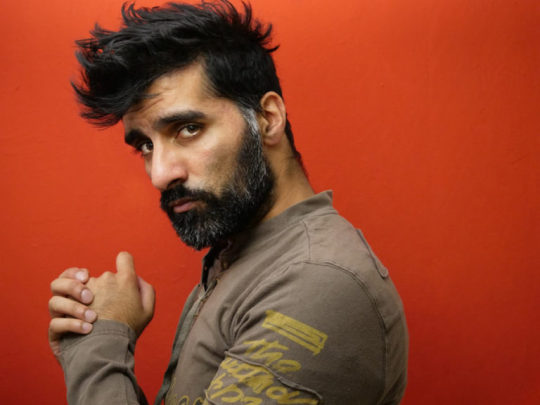
Between 2005 and 2006, Yosef was senior journalist with The Asian Today & Desi Xpress.In 2007, Yosef was appointed deputy editor of national entertainment magazine Ikonz.In 2008, he became a columnist for Fusian magazine. In July 2009, Yosef launched I Am Birmingham, an independent news website serving the West Midlands region, of which he was an editor-in-chief.
In October 2019, public letters written by LGBT+ Labour & LGBT+ Labour West Midlands accusing West Mayoral candidate Salma Yaqoob for homophobia, included claims Adam Yosef was previously employed by Yaqoob and had "called for violence against LGBT+ activists".The letters were shared and endorsed by Labour MPs Wes Streeting & Ben Bradshaw.Then Salma Yaqoob defended her relationship with Yosef, stating: "Adam is a member of the LGBTQI+ community and is an active campaigner for LGBTQ+ rights, who was pivotal in promoting Muslim groups' involvement in Birmingham Pride."Yaqoob's responses to the points made in the letters were backed by LGBT+ activists Owen Jones,Saima Razzaq, Pav Akhtar, who described Yaqoob as an ally.LGBT+ Labour West Midlands has since removed the original letter from their Twitter account.
Activism
In 2003, Yosef co-founded the interfaith Saltley Gate Peace Group, a community peace initiative which was formed in response to the threat of war in Iraq as a part of the growing peace movement in Britain following 9/11, and he was Community & Interfaith Liaison Officer for the Birmingham Stop the War Coalition during this period.He has been actively involved in community work which is related to the Lozells riots, the Alum Rock terror raids & campaigning against radical groups in the Midlands.
In his early twenties, Yosef slept rough on the streets of London before being assisted by The Salvation Army. As a result, founded the Birmingham Food Drive in 2012, which regularly provides food, clothes and essential items to homeless people in the city, and is an active supporter of youth homelessness charity St. Basils.He has also written for Pavement, the magazine for the rough sleepers in the UK.
Between 2011 and 2017, Yosef co-organised the Birmingham Zombie Walk, an annual event which raised thousands of pounds for Birmingham Children's Hospital, as part of an ongoing commitment to the charity.In 2015, Yosef co-founded the Birmingham chapter of the national anti-racism organisation Stand Up To Racism.
In 2021, Yosef co-founded Birmingham Against LGBTQI+ Hate, alongside queer muslim activists Saima Razzaq & Salman Mirza.The group organises rallies against homophobic attacks in the city and has called on city leaders to facilitate better relationships between communities.
Honours
In November 2017, Yosef was nominated & shortlisted for the Inspirational Man accolade at the Birmingham Inspiration Awards.In September 2018, Yosef was nominated & shortlisted for the Excellence in Media accolade at The Birmingham Awards. In 2019 and 2021, he was nominated in the Positive Role Model (LGBT) category for the National Diversity Awards. In 2020, Yosef was presented with an honorary award for 'Outstanding Contribution to LGBTQ+ Equality' award by Midlands Zone magazine.
2 notes
·
View notes
Photo


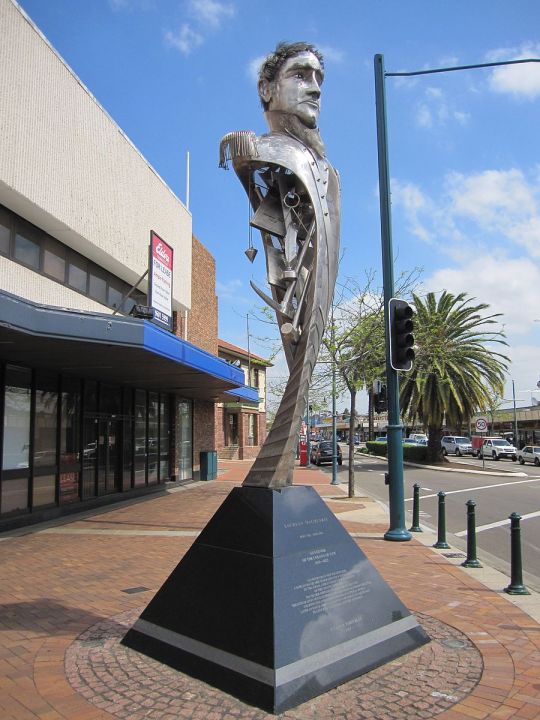
On January 31st 1761 Lachlan MacQuarie, was born on Ulva, a small isle off the island of Mull.
Lachlan joined the Army in 1776 (aged 14) and served in Nova Scotia as well as New York and Jamaica. As a lieutenant he served in India from 1787 to 1801 and later in Egypt where he was involved in defeating the army of Napoleon. In 1810 Macquarie became Governor of New South Wales at a time when it was still being used as a penal colony. The previous Governor had been Captain Bligh of the “Bounty”.
Macquarie followed a policy of encouraging the former convicts to settle in Australia - despite opposition from the “free settlers” who wanted to retain privileges only for themselves. Australia would be a different place if he had not succeeded. He transformed Australia into a thriving country and Sydney from a shanty town to a Georgian city and is regarded as the “Father of Australia”.
His policy concerning the Aboriginals was an expression of the same humanitarian conscience. He organized the Native Institution (a school for Aboriginal children), a village at Elizabeth Bay for the Sydney tribe, an Aboriginal farm at George’s Head. Orders of merit and even an old general’s uniform were bestowed on deserving chiefs.
It must be noted also that he ordered The Appin Massacre, to round up all Aboriginal people in the area after some unrest. Those who resisted were to be shot. On 16 April 1816, at least 14 were killed by shooting; others were driven to jump to their deaths into a rocky gorge, near Broughton Pass.
So he wasn’t perfect, but who is, a bit of a rogue as well by all accounts, was adverse a wee bit of embezzlement, but managed to wriggle out of it, “laws” he laid down were of the strict Presbyterian upbringing on the Islands on the Inner Hebrides, nude sunbathing was banned as was “shooting a neighbour’s dog on a Sunday” As a Scot his ability to have a good drink were evident, of his army life in India he “took to the field” with “eight dozen bottles of brandy and Madeira” and “a quantity of gin”. One of his diary entries, penned after a big night out, shakily read, “No beer for three months’!
For the Australians reading this Lachlan also set aside land in Sydney for "recreation and amusement of the inhabitants of the town” He named it Hyde Park, it was here Australia’s first sanctioned horse racing took place. At one of the fairs at the park he organised, “ladies raced in sacks for a cheese” where men would bet on the results and have a laugh! At another two men competed in a mile foot race before slugging it out for 56 rounds in Australia’s first bare knuckle prize fight. Now the remark about the sack race might make you think he was a misogynist, maybe he was, but he was ahead of his time and a revolutionary for the fairer sex, giving plum jobs to women, with reformed banknote thief Elizabeth Killett appointed to run the Sydney Market.
But his liberal attitude to the convicts finally was his downfall, Macquarie’s critics sparked a British government inquiry into his rule and the governor resigned, setting sail for Britain in 1822 with a shipload of kangaroos for his friends and patrons it was said that…
“as a Scotsman he was drawn to an animal with an inbuilt sporran”. Other men may lay claim to be “The Father of Australia” but are any as colourful as oor Lachlan?
Macquarie died in London in 1824 while fighting charges made against him as Governor. He was buried in a Mausoleum on the Isle of Mul in a mausoleum near Salen with his wife, daughter and later son. The grave is maintained by the National Trust of Australia and is inscribed “The Father of Australia”.
As I stated earlier, and with a lot of these anniversaries about people born during the days of the British Empire, Macquarie was heavily involved in atrocities. I will point to one quote attributed to him....... in 1816 around the time of the Appin massacre, that all Indigenous people “from Sydney onwards are to be made prisoners of war, and if they resist they are to be shot and their bodies hung from trees in the most conspicuous places near where they fall, so as to strike terror into the hearts of the surviving natives”
You can find out loads about him online one of the sources can be found at the link at the bottom. The BBC made a drama-documentary in 2011 called The Father of Australia, https://nativistherald.com.au/2018/04/20/australias-founding-fathers-lachlan-macquarie/
13 notes
·
View notes